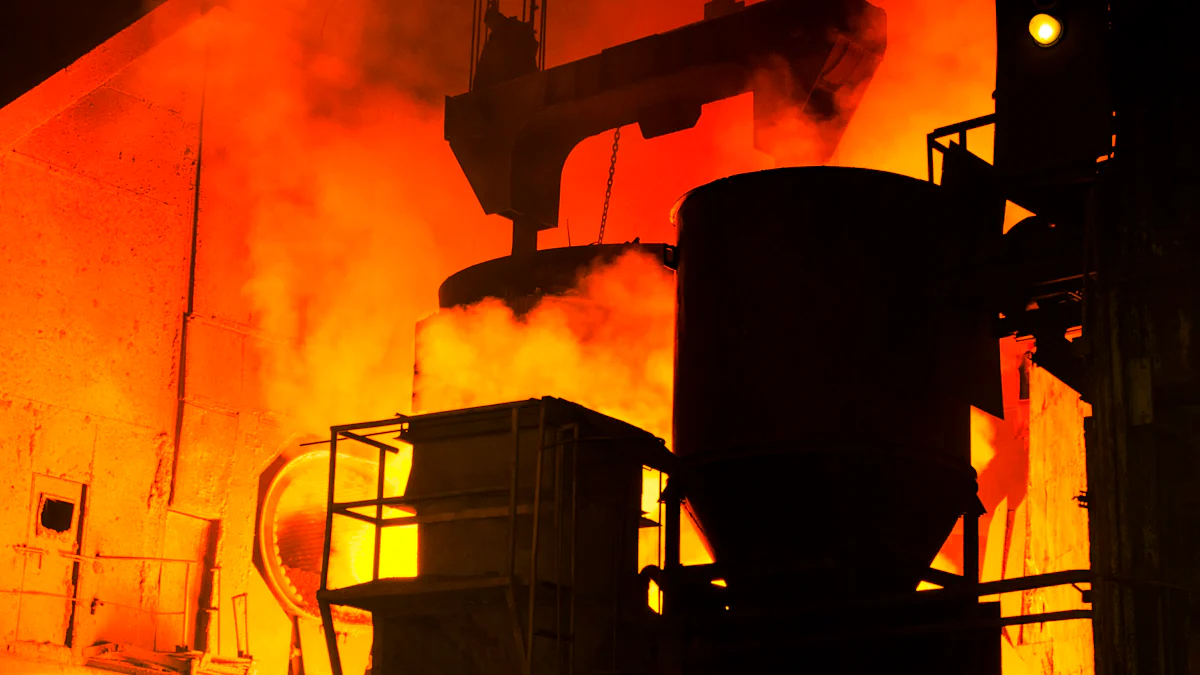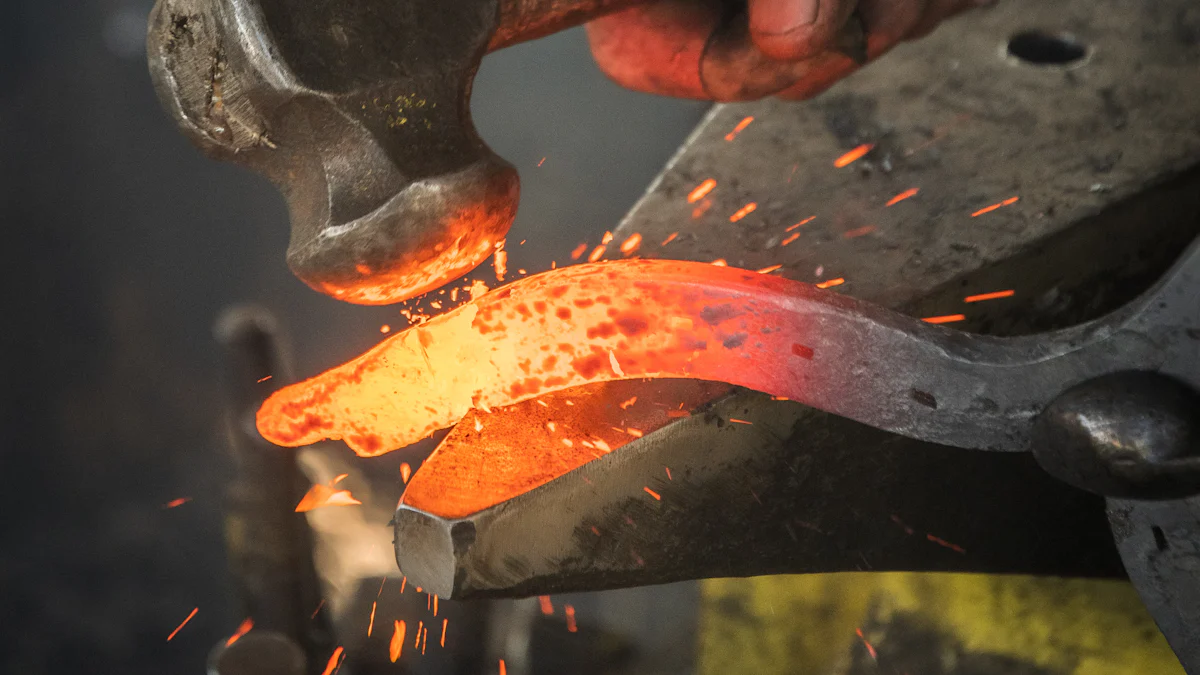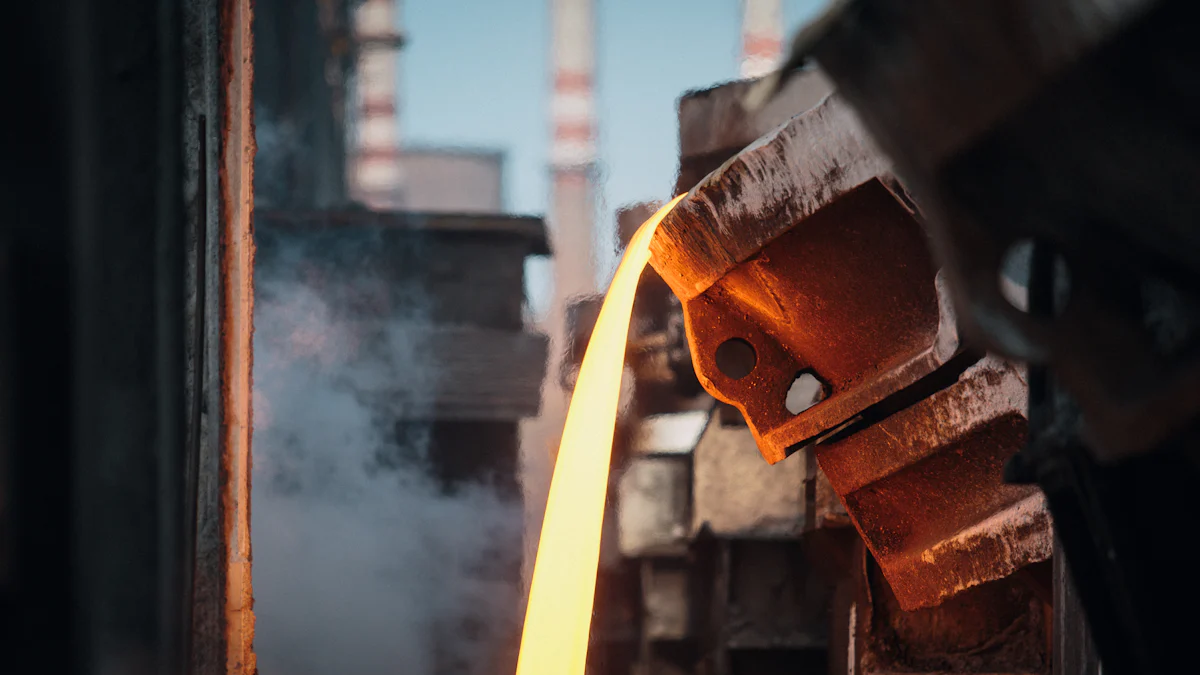Understanding the Different Types of Heat Treatment Processes

Heat treatment transforms the properties of materials, making them more suitable for demanding applications. You can use this process to enhance the strength, toughness, and durability of metals. It improves wear resistance, ensuring materials withstand friction and last longer. By hardening metals, heat treatment boosts tensile and yield strength, reducing the risk of fractures. The process of heat treatment is essential in industries like automotive, aerospace, and construction, where performance and reliability are critical. Different types of heat treatment processes allow you to tailor materials for specific needs, ensuring optimal results.
Annealing

Definition of Annealing
Annealing is a heat treatment process designed to improve the machinability and ductility of metals. It softens the material, making it easier to shape and machine. This process also reduces internal stresses and refines the grain structure of metals, enhancing their overall performance.
Purpose of Annealing
You can use annealing to achieve several goals. It helps relieve internal stresses caused by previous manufacturing processes like welding or machining. This process also enhances the ductility of metals, allowing them to bend or stretch without breaking. Additionally, annealing improves the material's machinability, reducing friction and wear on tools during shaping. For materials like stainless steel, annealing resets their properties, preparing them for further processing.
The Annealing Process
The annealing process involves three main steps: heating, soaking, and cooling. You heat the metal to a specific temperature, hold it there for a set duration, and then cool it at a controlled rate. The cooling method depends on the desired properties of the material. Below are the common types of annealing processes:
Full Annealing
Full annealing involves heating the metal above its critical temperature and then cooling it slowly in a furnace. This method produces a soft and uniform structure, making the material easier to machine and shape.
Soft Annealing
Soft annealing is used to reduce hardness in materials like tool steels. You heat the metal to a lower temperature compared to full annealing and then cool it slowly. This process enhances the material's ductility and makes it more pliable.
Stress Relief Annealing
Stress relief annealing focuses on eliminating internal stresses without significantly altering the material's structure. You heat the metal to a moderate temperature and then allow it to cool in air. This method is ideal for components that need dimensional stability.
By choosing the appropriate annealing method, you can tailor the properties of metals to suit specific applications and benefits of heat treating.
Applications of Annealing
You encounter annealing in many industries due to its ability to enhance material properties. This process is essential for restoring the original physical characteristics of metals and other materials after they undergo forming or machining. By removing internal stresses and refining grain structures, annealing prepares materials for further shaping or use.
Here are some common materials that benefit from annealing:
Ferrous metals like steel
Copper and brass
Silver
Sheet metal, especially cold-rolled varieties
Manufactured components such as springs, washers, and saw blades
Drawn aluminum
Glass and plastic films
In manufacturing, annealing plays a critical role in improving the ductility of metals like steel, copper, and aluminum. This makes them easier to bend, stretch, or machine without breaking. For example, cold-rolled sheet metal undergoes annealing to remove grain deformations caused by the rolling process. Similarly, springs and washers are annealed to relieve stresses and ensure dimensional stability.
You also see annealing used in industries that work with non-metallic materials. Glass manufacturers use this process to reduce brittleness and prevent cracking during production. Plastic films undergo annealing to improve their flexibility and durability, making them suitable for packaging applications.
Normalizing
Definition of Normalizing
Normalizing is a heat treatment process that improves the mechanical properties of metals. It involves heating the material to a temperature above its critical point and then allowing it to cool in air. This process refines the grain structure of metals, making them stronger and more uniform. You can use normalizing to enhance the toughness and ductility of materials, preparing them for further processing or use.
Purpose of Normalizing
The main goal of normalizing is to improve the performance of metals by refining their internal structure. This process reduces residual stresses that may form during manufacturing. It also enhances the toughness of metals, making them less likely to crack under pressure. Normalizing increases ductility, allowing materials to bend or stretch without breaking. Additionally, it prepares metals for machining by creating a more uniform and workable structure.
Compared to annealing, normalizing offers several advantages:
Increased ductility and toughness
Faster cooling process, which saves time
Cost-effectiveness due to reduced energy consumption
Lower residual stresses, improving material stability
These benefits make normalizing a preferred choice for many applications.
The Normalizing Process
The normalizing process consists of three steps: heating, soaking, and cooling. First, you heat the metal to a temperature above its critical range. This temperature varies depending on the type of metal, but it is typically between 750°C and 980°C. Next, you hold the metal at this temperature for a specific period to allow the grain structure to transform. Finally, you let the metal cool in air at room temperature. This controlled cooling process ensures a uniform grain structure and improved mechanical properties.
Normalizing is faster than annealing because it uses air cooling instead of furnace cooling. This reduces production time and costs, making it a more efficient option for steel heat treatment. You often see this process used in the manufacturing of gears, shafts, and other components that require strength and toughness. By normalizing, you can achieve a balance between hardness and ductility, ensuring the material performs well under stress.
Applications of Normalizing
Normalizing plays a vital role in industries where strength, ductility, and resistance to brittleness are essential. You can find this process used in a wide range of applications due to its ability to enhance the mechanical properties of metals.
In the automotive industry, normalizing is often applied to ferritic stainless steel stampings. These components may experience work hardening during forming, which can reduce their ductility. By normalizing, you restore their flexibility and make them more suitable for use in vehicles. Similarly, the nuclear industry benefits from normalizing nickel-based alloys. Welding can alter the thermal microstructure of these materials, but normalizing helps refine their grain structure and improve their performance under extreme conditions.
Construction projects also rely on normalized materials. Metal bars used in building frameworks and fence posts undergo normalizing to achieve a balance between strength and ductility. This ensures they can withstand heavy loads without becoming brittle. Heavy machinery equipment, such as axles and wheels, also benefits from this process. Normalizing improves the toughness of these components, making them more durable and reliable.
You can also see normalized components in railroad cars. The process reduces brittleness and increases ductility, ensuring the materials can endure the stresses of transportation. These improvements make normalizing a preferred choice for industries that demand high-performance materials.
By normalizing, you enhance the usability of metals across various applications. This process ensures materials meet the rigorous demands of modern industries, providing both strength and flexibility where it matters most.
Hardening

Definition of Hardening
Hardening is a heat treatment process that increases the hardness and strength of metals, particularly steel. You achieve this by altering the material's microstructure through controlled heating and rapid cooling. This process makes the metal more resistant to wear and deformation, which is essential for components exposed to high stress or friction.
Purpose of Hardening
The primary goal of hardening is to improve the durability and performance of materials. You use this process to enhance the wear resistance of tools, gears, and machine parts. Hardening also increases the tensile strength of metals, reducing the risk of failure under heavy loads. By applying this treatment, you can extend the lifespan of components and ensure they perform reliably in demanding environments.
The Hardening Process
The hardening process involves three key steps: heating, quenching, and tempering. First, you heat the metal to its austenitizing temperature, where its structure transforms into austenite. Next, you rapidly cool the material using a suitable quenchant. Finally, you temper the hardened metal to reduce brittleness and achieve the desired balance of hardness and toughness.
Quenching Methods
Quenching is a critical step in the hardening of steels. The choice of quenchant significantly impacts the final properties of the material. Common quenching methods include:
Brine Quenching: This method provides the fastest cooling rate, making it ideal for through-hardening. However, it may cause distortion or cracking in some materials.
Water Quenching: Water cools metals quickly but at a slower rate than brine. It is suitable for applications requiring high hardness with moderate risk of distortion.
Oil Quenching: Oil offers a slower cooling rate, reducing the likelihood of cracking or warping. It is often used for intricate components.
Polymer Quenching: This method provides a controlled cooling rate, balancing hardness and minimizing residual stresses.
Each quenchant affects the microstructure of the steel differently. Faster quenching methods promote martensitic structures, while slower methods may result in ferrite or pearlite. Industries like aerospace and automotive rely on precise quenching techniques to minimize distortion and ensure consistent performance. By selecting the appropriate quenchant, you can optimize the hardening treatment for specific applications.
Applications of Hardening
Hardening plays a vital role in industries where durability and wear resistance are critical. You can find this heat treatment process applied to a wide range of components to enhance their performance and lifespan. Below are some common applications of hardening:
Tool Manufacturing: Hardening is essential for tools like drill bits, cutting blades, and chisels. These tools require high hardness to maintain sharp edges and resist wear during use. By applying heat treatment steel hardening, you ensure these tools perform reliably under intense conditions.
Automotive Industry: Many automotive parts, such as gears, crankshafts, and axles, undergo hardening. This process improves their ability to withstand heavy loads and friction. Hardened components in vehicles reduce the risk of failure, ensuring safety and efficiency.
Construction Equipment: Hardening strengthens construction tools and machinery parts, including excavator teeth, bulldozer blades, and hammers. These components face constant stress and impact, making durability a top priority.
Aerospace Applications: Aircraft components, such as landing gear and turbine blades, benefit from hardening. This treatment enhances their resistance to wear and deformation, ensuring they perform well under extreme conditions.
Manufacturing of Bearings: Bearings require exceptional hardness to reduce friction and support rotating parts. Hardening ensures they maintain their shape and function over time, even under high pressure.
Tip: When selecting hardening for your project, consider the specific requirements of the material and application. This ensures you achieve the desired balance of hardness and toughness.
By using hardening, you can significantly improve the performance of heat treatment steel components. This process ensures materials meet the demands of modern industries, providing strength and reliability where it matters most.
Tempering
Definition of Tempering
Tempering is a heat treatment process that reduces the brittleness of hardened metals while maintaining their strength. You achieve this by reheating the material to a specific temperature below its critical point and then cooling it at a controlled rate. This process improves the toughness and ductility of metals, making them more suitable for demanding applications.
Purpose of Tempering
The main purpose of tempering is to balance hardness and toughness in materials. After hardening, metals often become brittle and prone to cracking under stress. Tempering helps you address this issue by relieving internal stresses and refining the microstructure. This process also enhances the material's ability to withstand impact and deformation. By tempering, you can ensure that heat treatment steel components perform reliably in high-stress environments.
Tempering is especially useful in applications where both strength and flexibility are critical. For example, tools, springs, and structural components benefit from this process. It allows you to tailor the properties of the material to meet specific performance requirements.
The Tempering Process
The tempering process involves three key steps: heating, holding, and cooling. First, you heat the hardened metal to a temperature below its critical range. The exact temperature depends on the desired properties of the material. For instance, lower temperatures increase hardness, while higher temperatures improve toughness. Next, you hold the metal at this temperature for a specific duration to allow the microstructure to stabilize. Finally, you cool the material in air or another medium to lock in the desired properties.
You can adjust the tempering process to achieve different results. For example, low-temperature tempering enhances wear resistance, making it ideal for cutting tools. High-temperature tempering improves ductility, which is essential for structural components. By controlling the process, you can optimize the performance of heat treatment steel for various applications.
Tip: Always consider the material type and application when selecting tempering parameters. This ensures you achieve the best balance between hardness and toughness.
Applications of Tempering
Tempering has a wide range of applications across industries that require materials with both strength and flexibility. You often see this process used to improve the performance of components that endure high stress or impact. By applying the tempering process, you can enhance the toughness of materials while maintaining their hardness.
In the automotive industry, tempering is essential for parts like springs, gears, and crankshafts. These components need to withstand constant motion and heavy loads without breaking. Tempering ensures they remain durable and reliable over time. Similarly, tools such as hammers, chisels, and cutting blades benefit from this heat treatment. The process reduces brittleness, allowing these tools to handle repeated impacts without cracking.
Construction equipment also relies on tempered materials. Excavator buckets, bulldozer blades, and other heavy machinery parts require a balance of hardness and toughness. Tempering makes these components strong enough to resist wear while maintaining the flexibility needed to absorb shocks.
In the aerospace sector, tempering plays a critical role in enhancing the performance of heat treatment steel components. Aircraft landing gear, turbine blades, and structural parts must endure extreme conditions. Tempering improves their resistance to deformation and ensures they perform reliably under stress.
Even household items like knives and scissors benefit from tempering. The process sharpens their edges and prevents them from chipping during use. By tempering, you can create products that are both durable and efficient.
Tempering is a vital step in heat treatment. It allows you to tailor materials for specific applications, ensuring they meet the demands of modern industries.
Case Hardening
Definition of Case Hardening
Case hardening is a heat treatment process that strengthens the surface of metal components while keeping their core softer. This method creates a hard outer layer, improving wear resistance and durability. Unlike other hardening processes that affect the entire material, case hardening focuses on the surface, balancing toughness and flexibility.
Key Difference: Case hardening creates a thin, hardened surface layer while maintaining a softer core. This contrasts with other hardening methods that alter the entire material.
Purpose of Case Hardening
You use case hardening to enhance the performance of components exposed to high friction or stress. This process increases surface hardness, making parts more resistant to wear and deformation. At the same time, the softer core retains toughness, allowing the material to absorb impacts without cracking. Case hardening is ideal for applications requiring both durability and flexibility.
Types of Case Hardening
Several methods of case hardening exist, each suited to specific applications. Below are the most common types:
Carburizing
Carburizing introduces carbon into the surface of low-carbon steel. You heat the material in a carbon-rich environment, allowing carbon atoms to diffuse into the surface. This creates a hard, wear-resistant outer layer while keeping the core tough. Carburizing is widely used for gears, shafts, and bearings in automotive and industrial machinery.
Nitriding
Nitriding involves diffusing nitrogen into the surface of steel or other alloys. This process occurs at lower temperatures compared to carburizing, reducing the risk of distortion. Nitriding produces a hard, corrosion-resistant surface, making it ideal for aerospace components, fasteners, and tools.
Cyaniding
Cyaniding uses a molten cyanide bath to introduce both carbon and nitrogen into the surface of the material. This method is faster than carburizing and nitriding, making it suitable for smaller components. Cyaniding enhances wear resistance and is commonly applied to tools, dies, and fasteners.
Note: Other specialized methods, such as flame hardening and laser hardening, provide localized surface hardening for intricate or high-wear areas.
Case hardening plays a crucial role in steel heat treatment. By selecting the appropriate method, you can optimize the performance of heat treatment steel components for demanding applications.
Applications of Case Hardening
Case hardening finds applications in industries where components must endure high wear and stress while maintaining flexibility. You can use this process to enhance the performance and lifespan of critical parts. Below are some common applications:
Automotive Industry: Case hardening improves the durability of gears, camshafts, and crankshafts. These components face constant friction and heavy loads. The hardened surface resists wear, while the softer core absorbs shocks, ensuring reliable performance.
Aerospace Sector: Aircraft components like landing gear and turbine blades benefit from case hardening. The process enhances their resistance to wear and deformation, making them suitable for extreme conditions.
Construction Equipment: Heavy machinery parts, such as excavator teeth and bulldozer blades, require a tough surface to handle abrasive environments. Case hardening ensures these components last longer without cracking.
Tool Manufacturing: Tools like wrenches, hammers, and cutting blades rely on case hardening for a hard, wear-resistant surface. This treatment allows tools to maintain their shape and function under repeated use.
Agricultural Machinery: Components like plowshares and harrow discs undergo case hardening to withstand soil abrasion. The process ensures these parts remain effective over extended periods.
Tip: When selecting case hardening for your project, consider the specific requirements of the material and its application. This ensures you achieve the right balance of surface hardness and core toughness.
Case hardening is especially effective for heat treatment steel components. By creating a hardened surface, you improve wear resistance without compromising the material's flexibility. This makes it a preferred choice for industries that demand both durability and performance. Whether you're working with automotive parts or industrial tools, case hardening offers a reliable solution for extending the lifespan of materials.
Nitriding
Definition of Nitriding
Nitriding is a specialized heat treatment process that hardens the surface of metals by introducing nitrogen into their outer layer. This process occurs at relatively low temperatures, typically between 500°C and 600°C, and does not require quenching. You can use nitriding to create a hard, wear-resistant surface while maintaining the material's core toughness. This makes it ideal for applications where durability and precision are critical.
Purpose of Nitriding
The primary goal of nitriding is to improve the surface properties of metals. This process enhances wear resistance, reduces friction, and increases fatigue strength. For example, nitriding can boost bending fatigue strength by up to 75%. It also forms a corrosion-resistant layer, protecting components from environmental damage. Unlike other hardening methods, nitriding causes minimal distortion due to its low processing temperatures. This makes it particularly useful for intricate or precision-engineered parts.
You might choose nitriding over other heat treatment methods for several reasons:
It significantly improves scuff and corrosion resistance.
It enhances wear resistance and reduces the coefficient of friction.
It minimizes distortion, preserving the dimensional accuracy of components.
These advantages make nitriding a preferred choice for industries like aerospace, automotive, and tooling.
The Nitriding Process
The nitriding process involves three main steps: preparation, nitriding, and cooling. First, you clean the metal surface to remove contaminants that could interfere with nitrogen diffusion. Next, you expose the material to a nitrogen-rich environment at controlled temperatures. This step allows nitrogen atoms to penetrate the surface, forming a hard nitride layer. Finally, you cool the material slowly to stabilize its properties.
There are several types of nitriding processes, including gas nitriding, plasma nitriding, and salt bath nitriding. Gas nitriding uses ammonia as the nitrogen source, while plasma nitriding employs an ionized gas to achieve precise control over the treatment. Salt bath nitriding immerses the material in a molten salt bath, offering uniform results. Each method has unique benefits, so you can select the one that best suits your application.
By using nitriding, you can enhance the performance of heat treatment steel components. This process ensures materials meet the demands of modern industries, providing both durability and reliability.
Applications of Nitriding
Nitriding offers significant advantages for industries that demand durable and precise components. You can use this process to enhance the performance of materials in applications requiring wear resistance, fatigue strength, and corrosion protection. Its ability to create a hard surface while maintaining a tough core makes it ideal for many critical parts.
You often see nitriding applied to materials like low-alloy steels, titanium, aluminum, and molybdenum. These materials benefit from the hard surface layer created during the process. Common components treated with nitriding include gears, crankshafts, camshafts, and valve parts. This process also improves the durability of extruder screws, die-casting tools, and forging dies. Even firearm components and plastic mold tools rely on nitriding for enhanced performance.
Industries such as automotive, aerospace, and tooling frequently utilize nitriding. For example, in the automotive sector, nitriding strengthens gears and crankshafts, ensuring they withstand high stress and friction. In aerospace, this process enhances the wear resistance of turbine blades and other precision-engineered parts. Tool-making industries use nitriding to improve the lifespan of dies and molds, which endure repeated use under extreme conditions.
The table below highlights some steel alloys commonly treated with nitriding and their industrial applications:
Steel Alloys | Industries Utilized |
|---|---|
SAE 4130 | Automotive |
SAE 4140 | Firearms |
SAE 4150 | Die fabrication |
SAE 4340 | Tool-making |
AISI 8640 | Machinery, Automotive and Aerospace |
17-4 (SAE 630) | Equipment such as pipes, valves and tanks |
15-5 | Equipment such as pipes, oil well pipes, valves, fasteners and oil tanks |
400 series stainless | Petrochemical industry, home appliance manufacturing, automotive industry, and architectural decoration. |
Nitralloy 135® | Aircraft gears, pinions, crankshaft bolts and other precision mechanical parts. |
Nitriding complements other heat treatment processes like hardening by providing additional surface protection. When applied to heat treatment steel, it creates a durable outer layer that resists wear and corrosion. This makes nitriding an essential step for components that require both strength and precision.
By incorporating nitriding into your manufacturing process, you can significantly extend the lifespan of critical parts. This ensures your components perform reliably, even in the most demanding environments.
Heat treatment processes allow you to customize material properties to meet specific needs. Each method, such as hardening or tempering, serves a distinct purpose. By selecting the right process, you can enhance the performance and durability of components. For example, steel heat treatment improves strength and wear resistance, making it ideal for demanding applications. Properly treated materials last longer and perform better, benefiting industries like automotive and aerospace. When working with heat treatment steel, understanding these processes ensures you achieve the best results for your projects.
FAQ
What is the purpose of heat treatment?
Heat treatment improves the mechanical and physical properties of materials. It enhances strength, durability, and wear resistance. You can use it to tailor materials for specific applications, ensuring they perform better under stress or in demanding environments.
How does annealing differ from normalizing?
Annealing softens metals, making them easier to machine and shape. Normalizing, on the other hand, refines the grain structure and improves toughness. You would choose annealing for ductility and normalizing for strength and uniformity.
Why is tempering necessary after hardening?
Tempering reduces the brittleness caused by hardening. It balances hardness and toughness, ensuring the material can withstand stress without cracking. This step is essential for components that require both strength and flexibility.
What industries benefit the most from heat treatment?
Industries like automotive, aerospace, construction, and tooling rely heavily on heat treatment. It ensures components like gears, turbine blades, and structural parts meet performance and durability requirements.
Can heat treatment be applied to non-metallic materials?
Yes, heat treatment can also improve the properties of non-metallic materials like glass and plastics. For example, annealing reduces brittleness in glass and enhances flexibility in plastic films.
See Also
Understanding Various Powder Coating Techniques And Applications
Surface Treatment Techniques For Metal Cleaning And Preparation
Top 10 Key Surface Finishing Techniques For Metals
Importance of Metal Substrates In Today’s Industrial Applications
An Overview of Sandblasting: Fundamentals and Uses
About Hunan Puka
Established in 2016 and based in Hunan, China, with a liaison point in Berlin, we are a Tier 2 supplier for the automobile industry. We specialize in the production of customized aluminum die-casting parts designed for machines with a closing force ranging from 280 to 800 tons, with subsequent manufacturing process CNC machining and surface treatment. Our commitment to quality is reflected in our accredited quality management system, certified by ISO9001:2015 and IATF16949:2016 standards.


